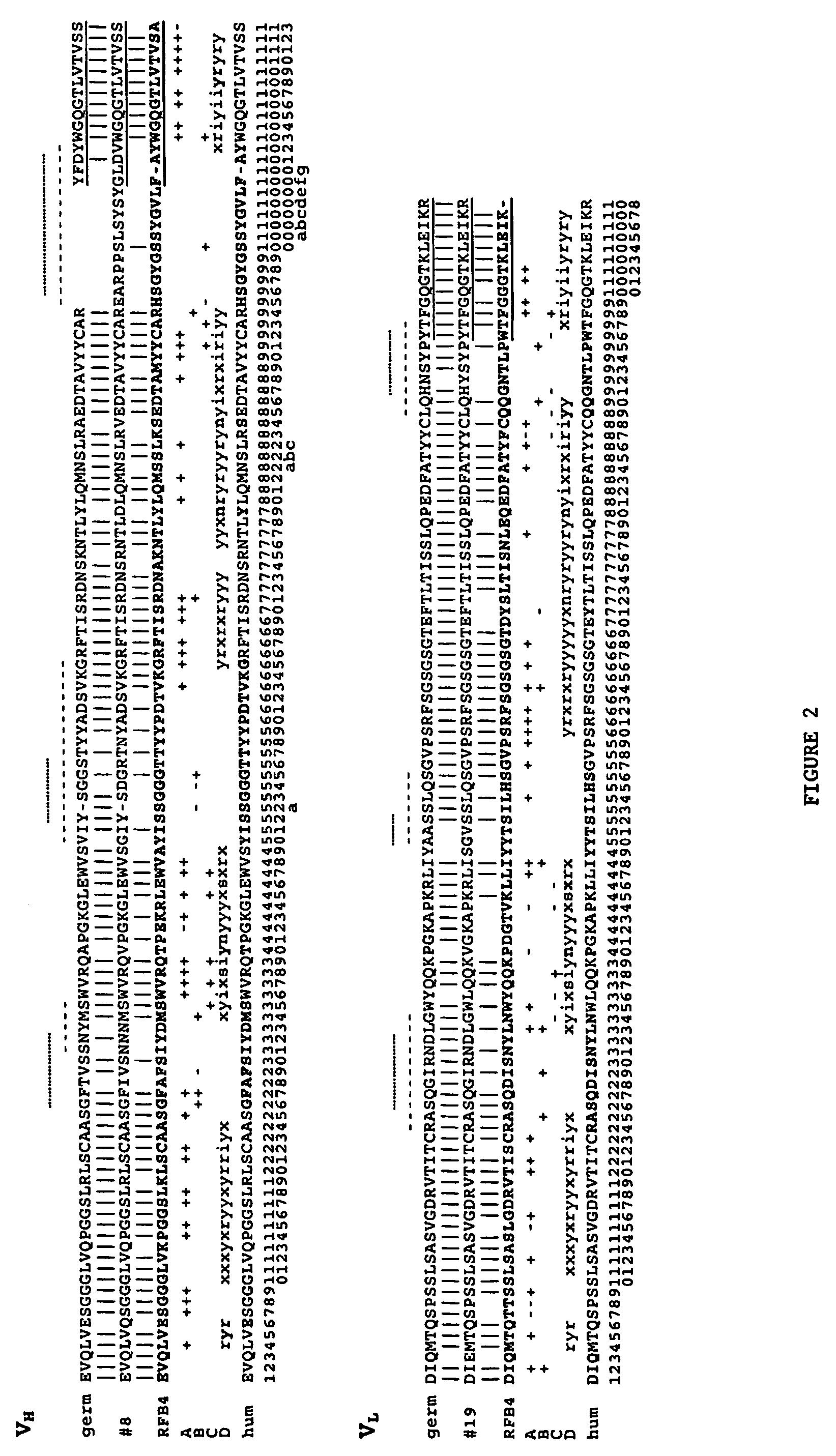Humanized antibody
a technology of humanized antibodies and monoclonal antibodies, applied in the field of humanized antibodies, can solve the problems of limited humanization efforts and limited use of monoclonal antibodies
- Summary
- Abstract
- Description
- Claims
- Application Information
AI Technical Summary
Benefits of technology
Problems solved by technology
Method used
Image
Examples
example 1
Preparation of Phase Display Library from Human B-cells
[0162]A scFv antibody phage display library with a repertoire of 5x 106 individual clones was generated from lymph node biopsies of two patients with B-cell non-Hodgkin lymphoma as described (Mao et al., Proc Natl Acad Sci USA 96:6953-6958, 1999). To generate the libraries, antibody variable gene segments of the entire B cell repertoire of these patients were amplified by PCR and cloned into a phagemid vector. The variable regions were thus expressed as randomly associated variable domain fragments on the surface of filamentous phage. This library was subjected to four rounds of in vitro panning on Daudi tumor cells as described (Schmidt et al., Biotechniques 26:697-702, 1999). A pool of enriched scFv antibodies was obtained and several phage antibodies that had good production characteristics, that is produced >1 mg / l bacterial culture, were identified and sequenced. The sequences of some of these clones are provided in the Tab...
example 2
Generation of Humanized RFB4 scFvs
[0184]A scFv comprising the human VH#8 heavy chain and the VL#19 light chain, respectively (FIG. 2) was first constructed. This construct was produced as soluble protein but binding was not specific to the CD22 antigen (data not shown). Six specificity grafted scFv mutants were generated subsequently (Table II).
[0185]In order to generate an scFv with good production properties, i.e., expression characteristics, the VL and VH encoding genes were synthesized by overlap extension PCR techniques, considering an optimized codon usage for E. coli for primer design.
[0186]CDR-grafted variant scFv SGO was generated by sequential PCRs using eight overlapping oligonucleotides each for the construction of VH and VL and overlap extension techniques as described (Ye et al., Biochem Biophys Res Commun 186:143-149, 1992). A standard (Gly4Ser)3 linker connecting the VH and VL domains was likewise introduced by PCR. Silent mutations were introduced into primers such ...
example 3
Expression and Purification of SG scFv Variants
[0187]The E. coli strain TG1 (Stratagene, La Jolla, Calif.), transformed with the scFv expression plasmid, was grown at 37° C. and 230 rpm in 1000 ml 2YT medium containing 100 μg / ml ampicillin and 100 mM glucose (2YTGA). Cells were pelleted by centrifugation after reaching an OD600 of 0.8-1.0 at 1500 g for 20 min at 20° C. and resuspended in the same volume of fresh 2YT medium containing 100 μg / ml ampicillin, 0.4 M sucrose and 1 mM IPTG. Induction was performed at 19° C. for 18-20 h. Bacteria were pelleted by centrifugation at 7000 g, 30 min at 4° C., resuspended in 5% of the initial volume in periplasmic extraction buffer (50 mM Tris, 1 mM EDTA, 20% Sucrose, pH 8.0) and incubated for 1 h on ice. The suspension was centrifuged at 30,000 g at 4° C. for 1 h and the soluble scFv-containing supernatant was thoroughly dialyzed against SP10 buffer (300 mM NaCl, 50 mM NaH2PO4, 10 mM imidazole, pH 8.0). The dialyzed crude periplasmic extract wa...
PUM
| Property | Measurement | Unit |
|---|---|---|
| temperature | aaaaa | aaaaa |
| temperature | aaaaa | aaaaa |
| pH | aaaaa | aaaaa |
Abstract
Description
Claims
Application Information
 Login to View More
Login to View More - R&D
- Intellectual Property
- Life Sciences
- Materials
- Tech Scout
- Unparalleled Data Quality
- Higher Quality Content
- 60% Fewer Hallucinations
Browse by: Latest US Patents, China's latest patents, Technical Efficacy Thesaurus, Application Domain, Technology Topic, Popular Technical Reports.
© 2025 PatSnap. All rights reserved.Legal|Privacy policy|Modern Slavery Act Transparency Statement|Sitemap|About US| Contact US: help@patsnap.com



